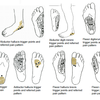ELEVATE YOUR GAME – A GUIDE FOR THE OPTIMAL FOOT WARM-UP

The foot, designed for a two-legged stance, carries out various essential functions:
- Weight bearing of the entire body
- Performing dynamic movements necessary for walking (and running, jumping...)
- Adapting to diverse surfaces during midstance
For ideal performance in both daily life and sports, the foot necessitates a blend of strength and flexibility. The muscles on the underside of the foot predominantly work together during the support phase of standing, upholding the foot's arches and countering forces that aim to collapse the longitudinal arch when pressure is exerted from the heel and transmitted to the forefoot. The muscles become most active in the later portion of the movement to stabilize the foot in the push-off phase, at which time forces aim to flatten the transverse arch. Simultaneously, intrinsic muscles are also able to refine the efforts of the long muscles, with supination and pronation, enabling the plantar part of the foot to adjust to uneven ground. They are most active in fixing the foot or in increasing the pressure applied against the ground by the sole or toes to maintain balance.
Why is it vital not to overlook your feet during your warm-up routine?
While foot injuries and problems can result from various factors, some that we can control and some that we cannot, there are several foot conditions that can be triggered or intensified by a lack of proper warm-up, such as:
- Plantar Fasciitis: May strain the plantar fascia, leading to inflammation and heel pain.
- Achilles Tendinitis: A tight Achilles tendon can lead to irritation and even some acute injuries.
- Morton's Neuroma: May contribute to nerve irritation in the forefoot, leading to Morton's neuroma, characterized by sharp, shooting foot pain.
- Muscle Strains: Lack of proper warm-up may increase the risk of muscle strains in the foot or lower leg, resulting in discomfort and limited mobility.
- Stress Fractures: Inadequate warm-up can lead to undue stress on the bones, potentially increasing the likelihood of stress fractures in the feet.
- Arch Pain: Lack of flexibility and strength may lead to arch pain, affecting overall foot comfort and function.
- Turf Toe: May increase the risk of turf toe, an injury involving the big toe joint, resulting in pain and limited movement.
- Improper foot warm-up can also lead to many acute injuries of the foot, lower leg, and even injuries of the knee, hip, or back.
Ensuring a proper warm-up routine can significantly reduce the risk of these foot problems, support overall foot health, and enhance your athletic performance. Increasing circulation, flexibility, and range of motion is crucial in reducing the likelihood of injury and improving overall performance. Since feet are usually the only point of contact with the ground and among the most overburdened body parts while performing various levels of sport activities, you should always consider and implement:
1. FOOT MOBILIZATION EXERCISES
Use simple exercises like toe spreads, TRIGGER PAD exercises, barefoot walking/jogging, ankle circles, etc., engaging foot muscles, improving blood flow, and loosening the foot region generally.
2. ANKLE RANGE OF MOTION
Improve ankle joint ROM by increasing dorsiflexion with calf stretches (both knee extended and flexed). Start with static exercises like a seated stretch with a resistance band, standing heel drop stretch, or lunging calf stretch. After feeling a bit looser, continue with dynamic versions of the same exercises.
3. FOOT MASSAGE AND ROLLING
Equipment such as tennis, golf, or lacrosse balls, peanut balls, trigger pads, or any other foot rolling/massage gear to relieve tension and enhance circulation at the bottom of your feet. Focus on the foot zones that feel most tight or even painful, applying more pressure and rolling at those spots or their trigger points.
4. INTRINSIC MUSCLE ACTIVATION EXERCISES
These exercises help further awaken the muscles and prepare them for substantial forces. Towel scrunches, toe presses, heel raises (using a Curve as a wedge for toes), lunges, or squats on a trigger pad or with the heel elevated are just some examples.
5. SPORT-SPECIFIC (ACTIVITY-RELATED) WARM-UP
The final step should consistently involve exercises specific to your sport, customizing your foot warm-up to match its particular demands. For instance, dancers can incorporate point-and-flex routines, while basketball players may focus on jump and landing drills (including toe balancing).




